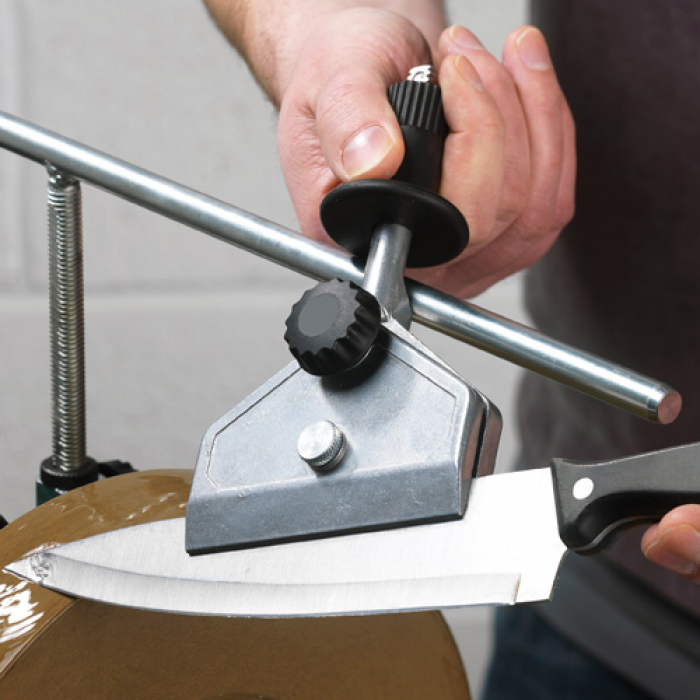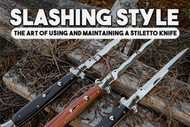Slashing Style: The Art of Using and Maintaining a Stiletto Knife
Posted by SwordsSwords on Sep 1st 2023
Italian Stiletto knives are the ultimate combination of form and function. With their sleek, slender design and razor-sharp blade, they are both a fashionable accessory and a deadly weapon.
However, like any slashing knife, stiletto knife also requires proper care and maintenance to ensure they remain effective and retain their cutting edge for years.
In this blog, we'll explore the art of using and maintaining a stiletto knife. From choosing the perfect, high carbon content knife blade to sharpening and storing it.
P.S: If you’re out in the market looking for switchblades for sale, then you’d absolutely LOVE our collection of automatic knives! No need to search anywhere else!
Selecting the Perfect Knife Blade

A high quality blade is the most critical component. Its sharp, pointed tip enables piercing and slashing motions. Careful consideration of material, point style, length, and other attributes results in a blade suited to your needs.
Stiletto blades are commonly crafted from high-carbon steel containing around 0.7% to 1.2% carbon content due to its strength, durability and ease of sharpening.
This material holds an edge well but requires protection from rust when not in use. Stainless steel offers less sharpness but greater corrosion resistance. Both have pros and cons to weigh.
Dual-edge blade for powerful thrusting
motions
Needlepoint or dagger blade for
precision work, and
Tanto points featuring a flat, angled
edge ideal for forceful slashing techniques.
Consider your intended application and skill level to determine the optimal point.
Length also impacts handling. Shorter blades under 4 inches enhance concealment, while longer blades between 4 to 6 inches provide more power and range. Balance length with maneuverability and legal restrictions.
Additional factors are blade thickness, grind type, and ergonomic handle design. With research and hands-on testing, you can select a stiletto blade perfectly tailored to your preferences and needs.
How to Sharpen a Stiletto Knife
A sharp stiletto knife is a safe and effective tool. But even the best switchblade knives will dull over time. That's why it's important to keep your stiletto knife sharp and maintain its edge.
There are a few ways to go about the knife sharpening process:

●Use a honing rod: A honing rod is a long, thin rod made of steel or ceramic that is used to straighten and align the edge of a blade. To use a honing rod, hold the rod vertically and draw the knife blade down the rod. Use a gentle, back-and-forth motion. This will help straighten out any nicks or burrs on the blade and keep it sharp.

●Use a sharpening stone: A sharpening stone is a flat, abrasive surface used to sharpen and hone blades. They have various grit sizes.
Generally, there are two types of sharpening stones: coarse and fine. Coarse stones are used to remove large amounts of material and repair damaged edges, while fine stones are used to refine the edge and polish the blade.
To use a sharpening stone, hold the blade at a 20-degree angle and draw it across the stone, using a back-and-forth motion.

●Use a sharpening jig: A sharpening jig is a device that holds the blade at a fixed angle and guides it across a sharpening stone. This helps ensure that the blade is sharpened evenly and consistently. Sharpening jigs are particularly useful for beginners or for sharpening serrated blades.
Storing Your Stiletto Knife
Proper storage is key to maintaining the longevity and effectiveness of your stiletto knife. Here are a few tips for storing your knife:
●Keep it dry: Moisture can cause rust and corrosion on your blade, so it's important to keep your stiletto knife dry when not in use. If you live in a humid climate, consider using a dehumidifier to prevent moisture from accumulating in your knife storage area.
●Keep it clean: It's important to clean your stiletto knife after each use to prevent bacteria and dirt from accumulating on the blade. Use a soft cloth and a small amount of warm water and mild soap to clean the blade and handle. Be sure to dry the knife thoroughly before storing it to prevent rust.
●Keep it protected: Italian Stiletto knives are delicate and can be damaged if not stored properly. To protect your blade, consider using a knife roll or a sheath to protect the blade and handle. If you're storing your knife in a drawer or cabinet, use a soft cloth or foam to cushion the blade and prevent it from being scratched or damaged.
How to Use a Stiletto Knife

When using a Italian stiletto knife for cutting tasks, hold the handle firmly and keep your fingers folded away from the blade. Apply downward pressure while making straight, controlled slicing motions.
For self-defense, hold the knife inverted with the blade facing downwards along your forearm. This provides maximum control and concealment until needed. If deploying the blade, target major muscle groups like biceps or thighs to disable an assailant, not vital areas.
Only employ these tactics as an absolute last resort to prevent serious harm, then disengage and summon authorities immediately..
Conclusion
Stiletto knives are versatile and fashionable tools that require proper care and maintenance to stay effective and safe. By choosing the right blade, keeping it sharp, and storing it properly, you can ensure that your stiletto knife is always ready for action.
Explore our ultimate guide to
buying the best switchblade knives for sale and make informed
choices!
You can also check out our ultimate buying guide
on stiletto knives to make sure you are getting your money’s
worth!

